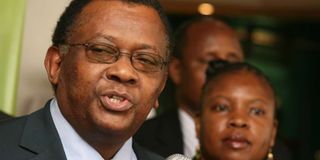After the 2007 mayhem, country saw the need to chart a new path

Mr Nzamba Kitonga (left), who was the CoE chairman, with his vice chairperson Atsango Chesoni in 2010.
What you need to know:
- The constitutional review roadmap was enacted with the 2007 post-election violence still in the minds of Kenyans.
- The Wako Draft is what was rejected in the 2005 referendum.
- The CoE came up with several propositions, including a parliamentary system of governance, a powerful senate and devolution.
The architecture of the 2008 Constitution of Kenya Review (CKR) Act helped by the PNU-ODM coalition government after the bloody 2007 election heralded the final antidote for new governance laws.
The country ushered in a new Constitutional moment on August 27, 2010 after long, tedious and divisive processes that led to arrests and deaths.
The Act safeguarded constitution-making from political and judicial exigencies that had marked previous processes.
The constitutional review roadmap was enacted with the 2007 post-election violence still in the minds of Kenyans.
It served to overcome barricades put on the road for a process that began in 1990 through the repeal of section 2A to allow multiparty politics.
Sufficient experiences
Ahead of August 2010, the country had had sufficient experiences for a new constitutional order – the Inter-Parties Parliamentary Group (IPPG) reform package of 1997, the 2002 Bomas Draft, the 2002 and 2007 General Elections and the 2005 referendum.
The agitators of the new constitution wanted governance strengthened by providing proper checks and balances as opposed to institutionalising individuals. They also wanted resources devolved to the grassroots.
The Act was a self-propelling mechanism with strict timelines. With the Act in place, the Committee of Experts (CoE) – a mechanism that would safeguard the review from undue political interference – was formed.
The team, chaired by Mr Nzamba Kitonga, revised the original harmonised draft constitution taking into consideration submissions by Kenyans.
It was basically a continuation of the process started by the Constitution of Kenya Review Commission (CKRC) in 1999.
Primary documents
In coming up with a new constitution, the committee used three primary documents.
There was the CKRC that came up with a report after collecting views from across Kenya in 2002.
The report was later referred to as the Ghai Draft, named after Yash Pal Ghai who chaired the CKRC. It is what was discussed at the Bomas of Kenya Constitution Review Conference.
It gave birth to the Bomas Draft, which would later be subjected to scrutiny to yield the Wako Draft, named after Attorney-General Amos Wako, now Busia senator.
The Wako Draft is what was rejected in the 2005 referendum.
In doing its work, the Kitonga team that had nine executive and two ex-officio members, used the Ghai, Bomas and Wako drafts to come up with the Harmonised Draft on January 8, 2010.
Experts
The CoE consisted of local and foreign experts. Other than Mr Kitonga, the committee had Ms Atsango Chesoni (vice chairperson), Mr Bobby Mkangi, Mr Otiende Amollo, Mr Abdirashid Abdullahi, Ms Njoki Ndung’u and Mr Wako.
The foreign component had Dr Chaloka Beyani (Zambia), Prof Christina Murray and Prof Fredrick Ssepembwa (Uganda).
Dr Ekuru Aukot was the committee director. Mr Wako and Dr Aukot did not participate in decision-making as they were ex-officio members of the committee.
The CoE came up with several propositions, including a parliamentary system of governance, a powerful senate and devolution.
However, this was not the end as the report was submitted to the Parliamentary Select Committee, chaired by the then Mandera Central MP Abdikadir Mohamed.
According to Mr Mkangi, the difficult work of coming up with a constitution had been done.
“Ours was to synthesise the documents that had the voices of Kenyans,” Mkangi said.
“We had to consider the views of wananchi and remain true to that. To some extent, politicians played negative roles but that was part of the process.”
Ms Chesoni said what made the team’s work easier was an understanding that its mandate was not to impose decisions on Kenyans but to harmonise the information “we already had”.
“We were tasked with coming up with a document that encompassed the views of Kenyans. That is what we did,” she said.
Ms Chesoni and Mr Mkangi said the CoE identified four areas that were contentious in coming up with a harmonised document. They were governance, devolution, people representation and transitional issues.
Though devolution had been agreed on, the problem lay in the architecture – whether to adopt a three or two tier system and what relationship between the government and the other units would be.
Governance system
There was push and pull on whether to adopt a parliamentary, presidential or hybrid system of governance.
There was also lockdown on having a bicameral system, if Judges who served under the old constitution should go home as well as when the new parliament should come in – immediately after the promulgation of the constitution or after the next election.
“The CoE wanted a system that was democratic, had the principle of separation of powers, the rule of law, national values among others,” Ms Chesoni said.
Mr Mkangi added that Kadhis Courts and abortion would also arouse debate.
However, the CoE unity and the architecture of the legal roadmap were the real deal to the constitution.
“We had a very short timeline and one of the first resolutions was that we would not ask for an extended period,” Mr Mkangi said.
“We only voted once and it was on a procedural matter.On the contentious issues, we debated with sobriety and arrived at decisions fast.”
The committee would later recommend a parliamentary system of governance, bicameral parliament, two-tier devolution among others.
At this point, the PSC came in.
The makeup of the committee was unique because it allowed Mr Mohamed, a backbencher to chair it so as to avoid the risk of having an individual with presidential or other ambitions higher up the political ladder, to lead it.
Mr Mohamed defeated Eldoret North MP William Ruto, now Deputy President, for the seat.
“That was the unwritten rule. To have someone not from the major tribes competing for power in the country to chair the special committee,” Mr Barasa Nyukuri, a governance expert, said.
The special committee had the face of Kenya.
Other than government ministers, assistant ministers and the Deputy Prime Ministers Uhuru Kenyatta and Musalia Mudavadi, it had the disabled, the marginalised and others.
Mr Mohamed said ODM pushed for a strong senate but PNU never wanted a senate.
ODM also wanted a parliamentary system but PNU preferred a presidential system of governance
“To balance the opposing extremes, PSC we settled on a weak Senate and a hybrid system of government so as not to cause division by portraying one side of the coalition government to be winning,” Mr Mohamed said.





